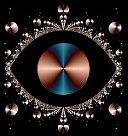|
The Burmese Cat
General Description
The seal sepia, or
sable, Burmese with
its rich, short,
glossy dark brown
coat and deep gold
eyes springs to mind
when one thinks
Burmese. But these
compact bundles
bring joy and love
to your world as
they give you
complete and
unconditional
devotion. They are
extremely
people-oriented and
tolerant cats that
are an ideal pet for
the whole family,
including younger
children. The
Burmese will happily
join in games and
play the role of
living doll. While
the sable Burmese is
the original color,
the Burmese now
comes in a variety
of other colors from
a warm blue to a
pinky-grey lilac to
a soft chocolate and
even combines these
colors with red and
cream. Imagine a
lilac
tortoiseshell-a
combination of soft
pinks mingled with
rich cream color of
Devonshire clotted
cream! These newer
colors are rapidly
becoming as popular
as the original
sable brown.
History
The Burmese we know
it today, was
developed in America
from a single cat:
Wong Mau. In 1930 a
sailor brought Wong
Mau from the Orient
and gave her to Dr.
Joseph G. Thompson
of San Francisco.
She was described as
"a rather small cat,
fine boned, but with
a more compact body
than that of a
Siamese, with
shorter tail, a
rounded,
short-muzzled head,
with greater width
between rounded
eyes." She was
walnut-brown in
color, with darker
brown points. Many
breeders considered
her a dark Siamese
but Dr Thomson
thought she was
distinctly
different. He
established a
program to isolate
and reproduce her
distinguishing
traits. In 1932 Wong
Mau was bred to Tai
Mau, a Seal Point
Siamese, and had
kittens of two
colors: some like
Siamese kittens and
others brown kittens
with darker points
like Wong Mau. Bred
to her son, Yen Yen
Mau, Wong Mau's
kittens
contained 3 colors:
some like Siamese
kittens, brown
kittens like Wong
Mau, and some dark
brown kittens. The
dark brown offspring
founded the Burmese
breed. It is now
accepted that Wong
Mau was actually a
Siamese x Burmese
hybrid.
On Mar 29 1955, the
first blue Burmese
kitten, Sealcoat
Blue Surprise, was
born in England.
Cats other than
sable had appeared
earlier, but most
Burmese breeders
chose to breed only
the sable cats. It
is now believed that
Wong Mau also
carried the genes
for dilution and
chocolate that
resulted in the
appearance of
chocolate, blue and
lilac kittens. The
red factor was added
later in Europe. The
Burmese was one of
the original breeds
TICA recognized in
June 1979.
Personality
Burmese are
extremely
sweet-natured,
people-oriented cats
who love to curl up
on any available
lap.
They are playful
cats and their
playful nature
extends to joining
the games of the
youngest family
members, easily
tolerating being
dressed up in doll's
clothes and carried
around like a living
doll. They are very
social cats that
thrive on company
and will be lonely
if there is no-one
home with them. They
are an ideal family
pet but if your busy
household means they
will be alone for
long periods of
time, you might want
to consider two so
they will be company
for each other.
Traits
Burmese come in a
range of solid and
tortoiseshell
colors: rich, dark
sable brown; a
medium, warm blue; a
warm, honey beige
chocolate with pink
or fawn tints; a
lovely lilac that
ranges in tone from
a bright pinkish
grey to a silvery
platinum with pink
tints; reds of a
light, golden
apricot with
melon-orange
overtones; rich,
warm deep creams
with hints of
apricot; and the
soft mingling of red
or cream with sable,
chocolate, blue or
lilac found in the
tortoiseshells. All
with seductive gold
eyes glowing with
their love for you.
In young cats, the
points will be
darker but as the
cat gets older and
the coat matures the
body color becomes
deeper and richer
until there is only
a very slight
difference between
it and the color on
the legs, head and
tail.
The Burmese is a
medium-sized,
compact cat with a
strong, well-muscled
body making it
surprisingly heavy
for its size. It has
a short, silky,
single coat that
hugs the muscular
body and is a joy to
stroke. The Burmese
is a sturdy cat like
a little bulldog
with females being
smaller than the
males. The head is
rounded and its
large,
innocent-looking
gold eyes give it a
sweet expression.
Their satin-like
coats require little
maintenance. A
weekly grooming with
a rubber brush to
remove loose hairs
will polish the coat
to a high gloss. The
oils from your hand
petting and stroking
the coat help
maintain its balance
and a quick wipe
with a chamois will
give that final
finishing touch.
The Burmese has a
soft, soft sweet
voice and will enjoy
a conversation with
you if encouraged.
These charming cats
with rich colors,
big gold eyes, and
velvet paws will win
your heart while you
wonder how you ever
lived without one in
your life.

Taken from The
International Cat
Association (TICA),
www.tica.org
RW SGC VINDOURO
TWISTED SISTER OF
PANDORA
BEST OF BREED KITTEN
2009 - 2010
RW SGC VINDOURO
TWISTED SISTER OF
PANDORA
BEST OF BREED CAT
2009 - 2010
SGC VINDOURO SIN
AFTER SIN OF PANDORA
BEST OF BREED CAT
CURRENTLY
BACK
to the Home page
or
read
What is a Bombay
Cat?
|